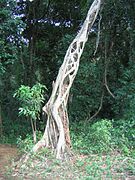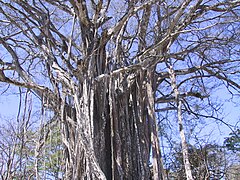
Strangler fig is the common name for a number of tropical and subtropical plant species in the genus Ficus, including those that are commonly known as banyans.
Species
Some of the more well-known species are:
- Ficus altissima – southern China and tropical Asia
- Ficus aurea – Florida, the Caribbean and Central America
- Ficus benghalensis – Indian subcontinent
- Ficus benjamina – tropical and subtropical Asia to northern Australia
- Ficus burtt-davyi – southeastern Africa
- Ficus citrifolia – Florida and tropical America
- Ficus craterostoma – tropical and southern Africa
- Ficus henneana – northern and eastern Australia
- Ficus macrophylla – eastern Australia and Lord Howe Island
- Ficus microcarpa - southeast Asia to Australia
- Ficus obliqua – Maluku Islands, Papuasia, northern Australia and southwestern Pacific
- Ficus tinctoria – Indian subcontinent and southern China to northern Australia and southwestern Pacific
- Ficus virens – tropical and subtropical Asia to northern Australia and western Pacific
- Ficus watkinsiana – eastern Australia
These all share a common "strangling" growth habit that is found in many tropical forest species. This growth habit is an adaptation for growing in dark forests where the competition for light is intense. These plants are hemiepiphytes, spending the first part of their life without rooting into the ground. Their seeds, often bird-dispersed, germinate in crevices atop other trees. These seedlings grow their roots downward and envelop the host tree while also growing upward to reach into the sunlight zone above the canopy.
An original support tree can sometimes die, so that the strangler fig becomes a "columnar tree" with a hollow central core. However, it is also believed that the strangler fig can help its support tree survive storms.
Gallery
-
 A fig seedling with thread-like roots on an unknown host
A fig seedling with thread-like roots on an unknown host
-
 The trunk of a bald cypress, encircled by fig roots
The trunk of a bald cypress, encircled by fig roots
-
 A strangler fig. The supporting tree, now dead, can also be seen
A strangler fig. The supporting tree, now dead, can also be seen
-
 Mature fig standing above the surrounding forest
Mature fig standing above the surrounding forest
-
 A cross section of a bald cypress at the Corkscrew Swamp Sanctuary, showing the fig roots inside it
A cross section of a bald cypress at the Corkscrew Swamp Sanctuary, showing the fig roots inside it
-
 View looking through the hollow core of a fig after the host has died and rotted away
View looking through the hollow core of a fig after the host has died and rotted away
References
- Zhekun, Zhou & Michael G. Gilbert (2003) "Flora of China" (Moraceae) 5: 21–73. hua.huh.harvard.edu Archived 2006-09-01 at the Wayback Machine
- Serventy, V. (1984). Australian Native Plants. Victoria: Reed Books.
- "Light in the rainforest" 1992 Tropical topics. Vol 1 No. 5, epa.qld.gov.au Archived 2007-07-01 at the Wayback Machine
- Margaret Lowman; H. Bruce Rinker (2004). Forest Canopies. Academic Press. pp. 180–. ISBN 978-0-12-457553-0.
- Richard, Leora.; Halkin, Sylvia (June 2017). "Strangler figs may support their host trees during severe storms". Symbiosis. 72 (2): 153–157. doi:10.1007/s13199-017-0484-5. S2CID 29202538.
External links
- The Tropical Rain Forest, including photos of strangler figs
- The Queen of Trees: Fig Trees – From the Sacred to the Strangler
- Being strangled may save this tree’s life
If an internal link led you here, you may wish to edit the linking article so that it links directly to the intended article. Categories: